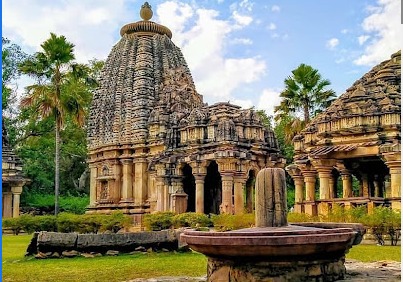Baroli Temples Complex, Rajasthan

Address
Baroli Temples Complex Baroli, Rawatbhata, Rajasthan 323305
Diety
Shiva
Introduction
The Baroli Temples Complex, also known as the Badoli temples, is located in Baroli village in Rawatbhata City in Chittorgarh district of Rajasthan, India. The complex of eight temples is situated within a walled enclosure; an additional temple is about 1 kilometre (0.62 mi) away. They are built in the Gurjara Pratihara style of temple architecture dated to the tenth century A.D All nine temples are under the control of the Archaeological Survey of India for conservation and protection
Puranic Significance
There are eight different temples in this complex. Though the history of the Baroli Temples is not very clear, they are reported to have been built during the Gurjara-Pratihara Empire in the 10th–11th centuries. They are one of the earliest temple complexes in Rajasthan Ghateshwar Mahadev Temple: Shiva temple as the name suggests and a Sringar Chauri or Rangamandapa, a pillared hall in front of it (probably used for ceremonial dance). The fact that this complex is dominated by Shiva becomes evident due to a large Nandi Bull just in front of the temple. The name Ghateshwar Mahadev comes from the ghata (pot) installed at the shikara (pinnacle), nested on a lotus. Small stepwell, which is believed to be of the same age as that of temple complex. Ganesha Temple: Dedicated to Ganesha, the elephant-headed god of wisdom, this temple faces east. While the main temple structure is built of stones, the superstructure of the shikara is brick. Dated to the 10th century, the shrine has a projecting vestibule and an atiratha sanctum. The door is without any decorations. The arms and feet of the image of Ganesha have been cut off, possibly by invading Islamic armies. Shiva temple in the Temple tank: This Shiva temple, also dated to the 10th century, has a sanctum with the divine linga in the middle of the sacred tank. Built in the Pancharatha style, it faces east. The portico in front of the sanctum is a single bay built with pillars. Vamanavatar Temple: The 10th-century Vamanavatar temple is a small shrine dedicated to a four-armed image of Vamana, the fifth avatar of the god Vishnu. The sanctum is covered with a flat slab as a ceiling. While a vestibule and an entrance are extant, the pinnacle is missing. Trimurti Temple: The Trimurti temple, dated to the 10th century, is partially damaged. It is situated in the south east of the temple complex. The extant structures, in the Gujara-Pratihara style of architecture, consist of a pancharatha-style sanctum topped with an elegant shikhara in Nagara architectural style, and also a vestibule. However, the mukhamandapa has been damaged. Ashtamata Temple: The Ashtamata temple, also known as the Mahishamardini temple, is located to the south of the Ghatesvara Mahadeva temple. The east-facing shrine was also built in the 10th century in the Pratihara architectural style. The temple, built in stone, consists of the sanctum, antarala (secondary chamber) and a mukhamandapa. Sheshashyan Temple: The Sheshashyan temple is a stone temple which is damaged. It was built in the 10th century in the Parihara style of architecture. Its existing feature consists of a sanctum in rectangular plan with projecting vestibule. The sanctum was probably topped by a Valabhi (wagon vault), now missing. The entrance to the sanctum does not have any decorations.
Special Features
The 10th-century Baroli Temples are of great architectural interest, consisting of temple structures built in the Gurjara-Pratihara architectural style, with exquisitely carved stonework. They are in differing stages of upkeep, with some in a semi-ruined state There are 8 major temples in Baroli and a ninth about one kilometre away. Four temples are dedicated to Shiva (including Ghateshwara Mahadeva Temple), two to Durga and one each to Shiva-Trimurti, Vishnu and Ganesha The Nataraja (Natesha) images carved in these temples are similar to those seen at Upramala. The sculpture has 16 arms and its headdress is matted. There is a large diadem carved at the centre top of the skull, which is “garnished with beaded swags.”
Festivals
Maha Shivratri
Century/Period/Age
10th century A.D.
Managed By
Archeological survey of India.
Nearest Bus Station
Baroli
Nearest Railway Station
Kota
Nearest Airport
Kota




